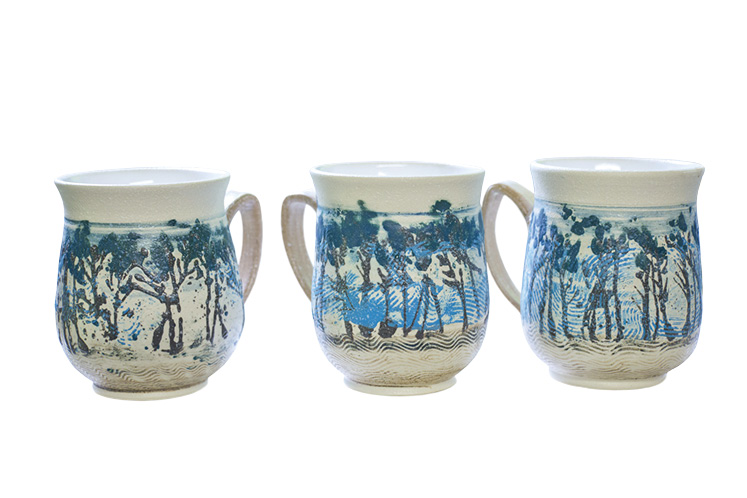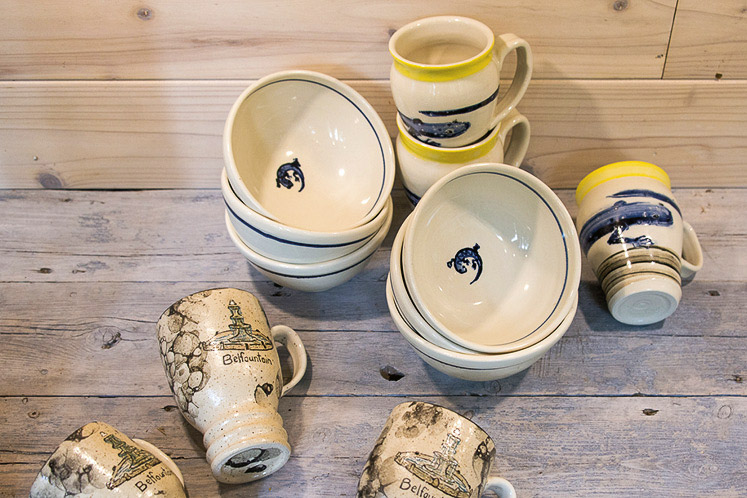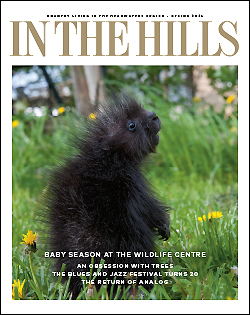Meet the Maker: Wendy Mitchell-Burke
Belfountain potter Wendy Mitchell-Burke connects with her community and nature through clay.
Just off Belfountain’s main road, a secluded lane engulfed by trees leads to Wendy Mitchell-Burke’s home and pottery studio, a converted treehouse perched on a slope a few steps away from the house. The fanciful workspace and showroom is lined with past work and current projects – including earthy mugs, bowls and teapots decorated with nature motifs – accumulated over 27 years.
On my recent visit, classical music is playing in the background as Wendy begins creating a large white stoneware pitcher. She starts with a lump of clay (her favourites are three kinds of stoneware from Oakville’s Pottery Supply House – speckled, white and red), then using a good amount of pressure, she “wedges” or kneads it to create consistency and remove any bubbles. Once it’s ready, she takes it to her pottery wheel and pulls up a low stool. After centring the clay on the wheel, she begins to work it, adding water from a nearby bowl so the clay stays slippery and doesn’t stick to her hands.
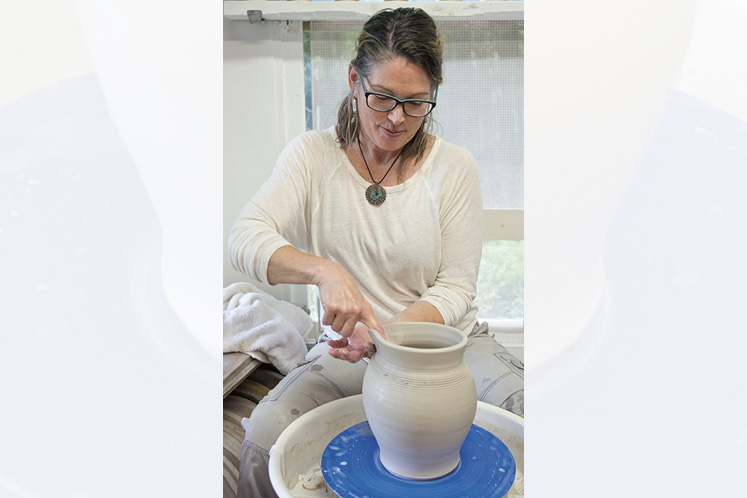
Wendy Mitchell-Burke works on a large stoneware pitcher in her treehouse pottery studio. Photography by Pete Paterson.
“I often get lost in the process, where I’ve totally just allowed myself to be in that zone for a few hours,” Wendy says. When she has finished a piece, she likes to reflect on the creative process. “It’s not always there, so when you tap into it, it’s pretty exciting.”
With one hand inside the emerging vessel and one on the outside, Wendy steadily pulls the clay higher and higher until she’s pleased with the wall thickness. With each pull she “compresses” and tidies the top rim by gently smoothing it.
Then she applies pressure to the outside to form the pitcher’s final profile. It will be set aside for a day, then flipped and set aside another day to partially dry to “leather hard,” then trimmed of rough edges and excess clay using a variety of handheld metal or wood tools. In the meantime, she will have made a handle and will attach it at this trimming stage. After it is completely dry, it will be ready to be “bisque fired” in her kiln at 1,940 F.
After the first firing, Wendy will decorate and glaze the pitcher, and “glaze fire” it again in the kiln at 2,240 F to vitrify it. Wendy has been experimenting with coloured liquid clays, or “slips.” Using the slips as paint, she draws designs on newsprint and firmly transfers them to pieces – as you would for a kid’s temporary tattoo. She removes the paper, leaving the slip image behind.
Then she covers them with clear or white glaze. On a shelf above her pottery wheel sits a newer series of mugs made this way, featuring nature scenes in browns, greens and blues against creamy white backgrounds.
In 1996, while Wendy was studying ceramics at Sheridan College, she and her husband, Dave Burke, were house hunting (they’d sold their home in London, Ontario). As they toured the Belfountain property serendipity struck. They learned the existing treehouse had once been a pottery studio, though it hadn’t been used in years. After finishing her studies and fixing up the treehouse, Wendy started taking commissions, and selling at markets and shows, all while the couple raised their two children, now 19 and 22.
In the seclusion of the treehouse, Wendy has found she can “really focus and explore.” She now holds private lessons here and in Belfountain’s Stillwater Atelier. She also visits Caledon schools to teach children from kindergarten to Grade 12. She describes teaching and encouraging others as “a big part of it” for her.
The surrounding natural habitat crept in (sometimes literally!) and is depicted in pieces such as mugs adorned with brook trout and salamanders. “I would lift pots off my deck and there would be a little salamander,” Wendy says. “That amazed me – I had never seen one before – and it inspired me at the same time to be aware of the uniqueness of this area.”
Wendy also works with the red-toned escarpment shale, aka Queenston shale, to make medallions she calls earth coins. (She makes a clay with shale dust “fines” left over from brick production at Brampton Brick.) Stamped with the map of Canada, the coins’ “value is that it’s from here,” she says. “The value of the escarpment basically and everything that grows off it that sustains us is connected to this shale.”
Wendy has shared the process with local students and organizations who want to customize the design. “I’ve always just wanted to connect with people, and make something that’s beautiful and that I can share in the community.”
Find Wendy on Instagram @treehouse_pottery
Related Stories
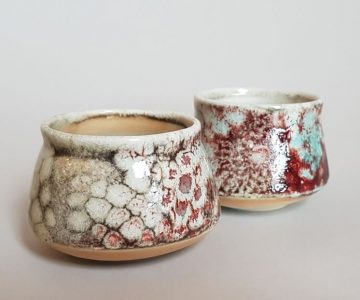
Ann Randeraad
Nov 22, 2019 | | ArtsThe self-taught Amaranth potter is the force behind a decade of the annual Empty Bowls food bank fundraiser at Alton Mill Arts Centre.
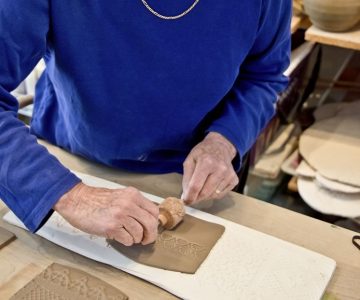
Meet the Maker: Mary Lazier
Mar 19, 2019 | | Made in the HillsMary fires up her pottery wheel only briefly, to attach the circular foot to the bottom of the bowl.

